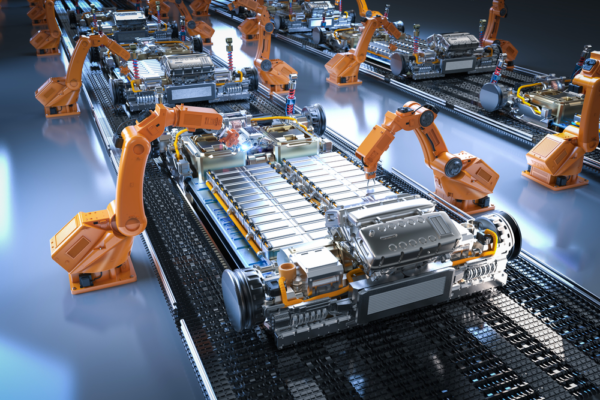
Although the EV market is currently experiencing a dip, it’s clear that EVs are the future of transportation. Automotive manufacturing has to adjust its approach as a result. Internal combustion engines (ICE) and their myriad components will continue to see a decline in demand, while parts specific to EVs need to scale up production quickly. Electric vehicle batteries manufacturing needs to reach ICE production levels for mass-scale EV assembly to be viable. EV battery manufacturing methods are evolving in response.
Innovations in Electric Vehicle Batteries Manufacturing
Cleaner Lithium Processes Are Incoming
One of the biggest issues facing electric vehicle batteries manufacturing today is the availability of lithium. Lithium is still the primary component in EV batteries and will likely continue to be for decades to come. However, lithium refinement processes are considered extremely hazardous to the environment due to their use of toxic solvents, which often find their way into groundwater and nearby soil. This, in turn, hinders the development of new lithium mines as locals protest their potential environmental impact.
Fortunately, new methods of production are in development. If your business is looking to get into the manufacturing of lithium cells, it would be wise to investigate these new methods and plan to implement them in the future. As companies and consumers seek cleaner EVs, manufacturers with these capabilities will stand out and be highly sought after.
Alternative Battery Compositions to Consider
Lithium isn’t the only material that can be used for batteries. While its energy density and its established supply chain still make lithium the king of EV batteries, there are other contenders on the horizon that may soon find their way into cars. Sodium batteries can be much more affordable, though they may not be ideal for long-range cars. Meanwhile, iron-based batteries are in development, with manufacturing facilities already being built in the US.
Companies that can deliver these alternatives will find a wide open market with little competition. Although R&D expenses will be higher, utilizing better R&D technologies can expedite development. For instance, using virtual testing simulations, you can determine which battery compositions and assembly methods would provide the best results before you start prototyping physical batteries.
EV Battery Manufacturing Demands Better Processes
Even if your company plans to stick to the tried-and-true lithium-based electric vehicle batteries manufacturing process, there’s room for improvement. If you intend to scale up lithium battery pack production to meet the growing demand for EV batteries, you need to rethink your entire production process. Going digital is essential to your success in the EV manufacturing space. A digital transformation enables you to capture data from every aspect of your operation and use that data to improve.
Although lithium is surprisingly cheap right now (around 1/6th of its 2022 figure), that won’t last long. Now’s the time to take advantage of more affordable lithium and invest in optimizing your processes to make your margins better. When lithium prices do rise, you’ll be in a better position to exploit your digital advantage. For EV battery production, there are some specific challenges to overcome to complete a digital transformation.
Data Collection and Analysis
A digital transformation starts with data collection. You need to be able to collect digital data throughout your manufacturing processes. This starts with digital inventory intake to precisely monitor raw material cost and consumption. Then, your machines need to output data as they operate. This data not only helps you maintain your equipment, but it can help you understand your production capacity and where new investments should occur.
You also need data regarding the finished product. For example, tracking failure rates and faulty part production rates can help you identify issues and fix them. Within EV battery manufacturing, there’s also a need to validate battery packs. As tolerances add up throughout the production chain, battery packs can diverge considerably in real-world performance. When individual cells vary significantly, it degrades the entire pack. By monitoring components as they pass through your production line, you can ensure high-quality output.
Automation
Once you have a robust data collection system in place, you’ll need to use that data to automate your processes more efficiently. Increasing production means cutting out elements where human error can be introduced. Furthermore, more automation means more uptime and therefore more output. Automation works by relaying information from one process to the next, which requires real-time data analysis and advanced communication networks on your factory floor.
Successful automation also has to account for errors. For example, a battery assembly machine may not always solder battery terminal contacts perfectly. Rather than manually testing each pack to find faults, an additional validation step could be used. A quick electrical test or a visual inspection using cameras could automatically isolate a potentially faulty battery pack and set it aside for further examination, allowing production to continue and speeding up post-production testing.
Rigorous Testing Is a Must
Speaking of testing, electrical vehicle batteries require a lot of it. Given the hazards involved with lithium-ion batteries, vehicle manufacturers have to take extra care with these components, and extensive physical tests to ensure the components’ highest quality must be performed.
Several technologies are key to ensuring exhaustive testing, such as automated test beds that can simulate driving conditions, digital twins, that are a digital representation of the part to be tested, or hardware-in-the-loop systems. One key technology that is acquiring increasing importance is software defined testing, which enables large-scale battery validation testing including performance, durability, and safety over a range of environmental conditions and drive, or failure, modes. This approach benefits from seamless integration, automated test sequences, real-time data analysis, and customizable algorithms, enabling to optimize battery performance, accelerate time-to-market, ensure compliance with industry standards, and reduce costs.
If you are looking for a solution for battery testing to improve the electric vehicle batteries manufacturing, contact SAAB RDS to schedule an appointment with one of our automotive test experts.
